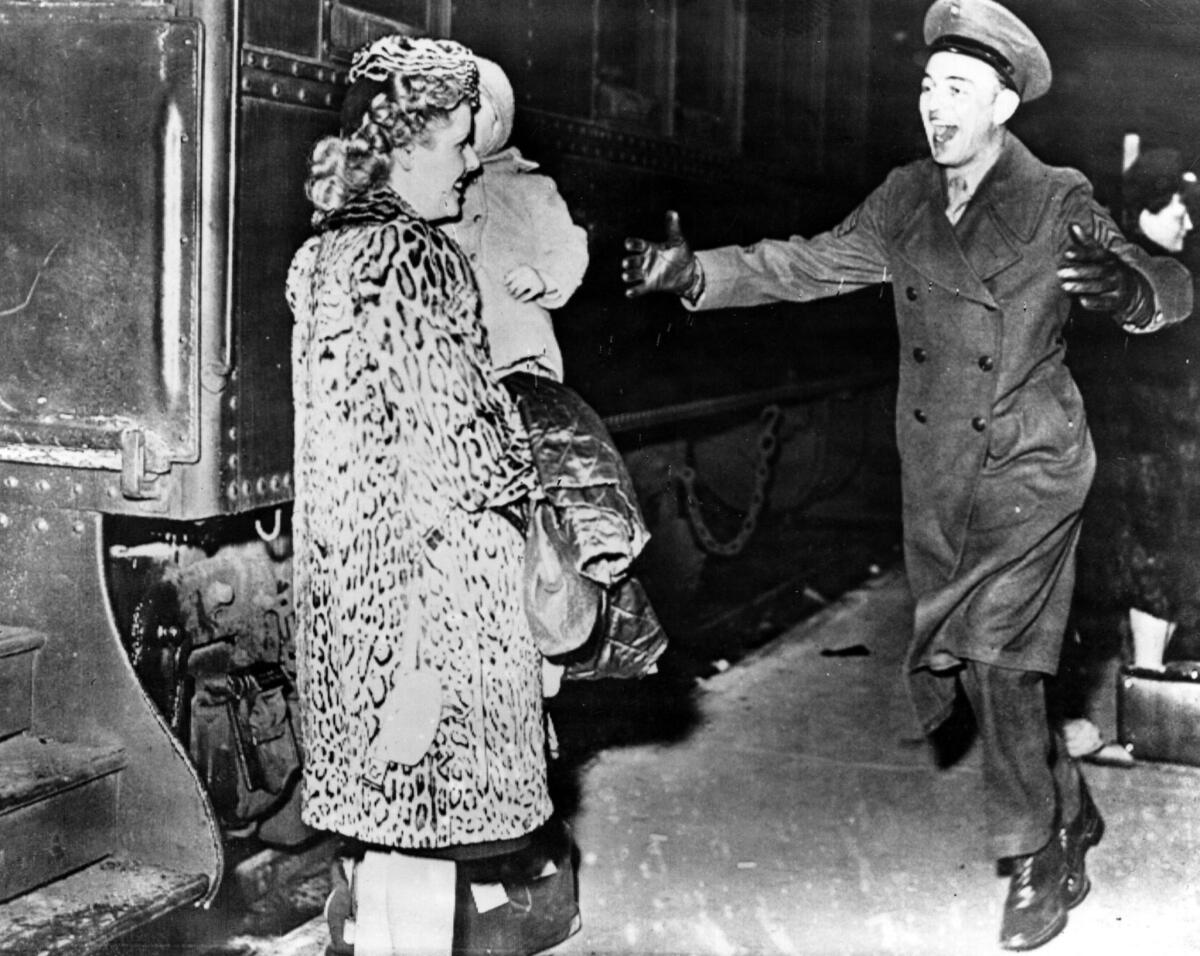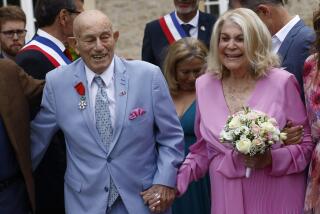Op-Ed: British war brides faced own battles during 1940s

- Share via
America’s attitudes toward immigration have always been complicated. Influenced by world events, the U.S. embraces some immigrants and demonizes others, and it can be difficult to understand the logic. Take the story of 70,000 would-be immigrants from Britain during the 1940s who all shared a common status — they were war brides.
In 1942, America and Britain were newly minted allies in the fight against Hitler, and maintaining a strong friendship between the two nations was essential for the war effort. To that end, the 2 million U.S. servicemen arriving in Britain to prepare for D-day were issued 38-page handbooks instructing them on how best to avoid upsetting their hosts during the so-called friendly invasion.
The rules encouraged friendliness but discouraged “special relationships.” The U.S. Army saw romance as a distraction from the work the soldiers had come to Europe to do, and it particularly discouraged marriage. In July 1942, an article in the armed forces magazine Yank ran under the headline “Don’t Promise Her Anything — Marriage Outside the U.S. Is Out.”
Strictly speaking, this was a slight exaggeration, but it captured the mood of the authorities. Only a month before, a War Department regulation had been put in place requiring overseas troops to obtain official permission to wed, on threat of court-martial. The process was remarkably complex, involving up to 15 forms, and it could take up to a year before permission was granted or denied.
Meanwhile, the British Red Cross was recruited to perform checks on prospective brides, visiting their homes, interviewing close relatives and compiling a report on each young woman. When news of this practice became public, it caused outrage, and the organization was accused of conducting “character investigations.”
But similar checks were also taking place in the United States, where the prospective groom’s personal situation was scrutinized and his pursuit of happiness made subject to the assessment of the authorities. To ensure that he would be able to support a wife, any bank savings he had were taken into account, and so too was the attitude of his parents toward the marriage.
Earl Houtz, a GI from Montana, had his application to marry rejected after his father refused to give consent — not because he objected to the marriage but as a matter of principle, because of his view that love is “a personal affair of two people” in which “no one has any right to interfere.”
Once these intrusive investigations were completed, an application had to be approved by a soldier’s commanding officer, who often tried to persuade him to change his mind. One man’s CO told him that he should hold out for an American girl after the war, and when he tried to argue, he was demoted.
Just as GIs had been the subject of suspicion from the British public (they were popularly described as “overpaid, oversexed and over here”), their brides were often suspected by Americans of being little more than gold-diggers — or, at best, economic migrants, using marriage as a ticket out of a poorer, battle-scarred country.
Despite the hurdles placed in front of them, more than 70,000 women married their American boyfriends, and as the war came to an end, they looked forward to beginning their lives in the United States. But they presented a logistical challenge. Not only were thousands of GIs still waiting for passage home, there were also, across the whole of Europe, more than 100,000 war brides eligible for free transport as Army dependents.
Many of the British women awaiting Army transport hadn’t seen their husbands since before D-day, and in June 1945, when they were warned that ships might not be made available for 10 or 12 months, they were furious. Some brides expressed their frustration at being made “wallflower wives,” as they were known in the American press, by protesting outside the U.S. Embassy in Grosvenor Square, which was receiving 500 visits from war brides daily. And when the recently widowed Eleanor Roosevelt visited London in November 1945, her hotel was besieged by an angry mob of brides and their babies, carrying placards reading “We Demand Ships” and “We Want Our Dads.”
Finally, the level of pressure led to action in Washington, with Congress passing the War Brides Act in December 1945. The law offered non-quota immigration status to the wives of U.S. servicemen, meaning that they could enter the country freely and without a visa.
But before the brides could set sail, there was a final hurdle: the infamous Tidworth processing camp on Salisbury Plain. The American base had been billed in the British press as a “country club” for GI brides, but it was anything but. The women slept in large, poorly heated dormitories and were fed by disgruntled German and Italian prisoners of war. The Army made it clear that it wasn’t interested in complaints. “You may not like the conditions here,” one group was told, “but remember, no one asked you to come.”
At Tidworth the brides were subjected to humiliating medical exams. Lined up in the camp theater, brides were required to disrobe while a doctor shone a light between their legs. For girls brought up in strait-laced 1940s Britain, it was a humiliation. Some were so upset that they fled the camp, forgoing their passage to America.
The vast majority, however, toughed it out, and a month after the War Brides Act was passed, the first voyage of Operation War Bride set off from Southampton to New York, with 452 brides on board a requisitioned ocean liner.
The U.S. government, the U.S. Army and the mistrust of their fellow countrymen had failed to halt this wave of female immigrants — the largest in U.S. history — and finally the hurdles of suspicion and red tape had been overcome. As the boats docked in New York, the brides were finally free to begin a much bigger journey.
Duncan Barrett is the coauthor, with Nuala Calvi, of the new book “GI Brides: The Wartime Girls Who Crossed the Atlantic for Love.”
Follow the Opinion section on Twitter @latimesopinion
More to Read
Sign up for Essential California
The most important California stories and recommendations in your inbox every morning.
You may occasionally receive promotional content from the Los Angeles Times.












